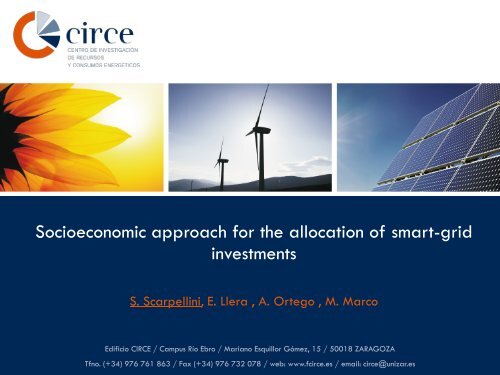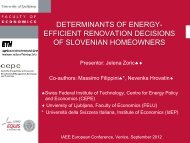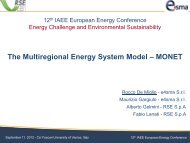presentation - 12th IAEE European Energy Conference
presentation - 12th IAEE European Energy Conference
presentation - 12th IAEE European Energy Conference
You also want an ePaper? Increase the reach of your titles
YUMPU automatically turns print PDFs into web optimized ePapers that Google loves.
Socioeconomic approach for the allocation of smart-grid<br />
investments<br />
S. Scarpellini, E. Llera , A. Ortego , M. Marco<br />
Edificio CIRCE / Campus Río Ebro / Mariano Esquillor Gómez, 15 / 50018 ZARAGOZA<br />
Tfno. (+34) 976 761 863 / Fax (+34) 976 732 078 / web: www.fcirce.es / email: circe@unizar.es
Index<br />
Sumario<br />
1. Introduction<br />
2. Costs and benefits of the smart grids<br />
3. Case study<br />
4. Conclusions
Introduction
Background<br />
• It is known that developing smart grids can help reach the<br />
<strong>European</strong> Union “2020 energy targets” moving towards new<br />
horizons like 2030.<br />
• It is common to find answers related to the technical aspects of<br />
smart grids but some questions like who will pay for converting<br />
the existing grid remain to be answered. Due to high up-front<br />
costs, smart grids can be perceived as high investment despite<br />
its cost effectiveness in the life cycle.<br />
• Its implementation overcomes not only technological but<br />
economic related issues.
Scope<br />
• Proper allocation of capital costs should take into account the<br />
particular interest of the stakeholders:<br />
o Distributors can see the capital upgrades reduced.<br />
o Consumers can obtain value-added services.<br />
o End-users can become electricity generators and obtain some income.<br />
o The “territory” can reach its objectives of sustainable growth, energy<br />
security, reduction of environmental pressure and social impacts.<br />
• This paper documents the methodology, key assumptions and<br />
results of a quantitative evaluation or the investment needed<br />
(costs) and a preliminary estimation of socioeconomic benefits<br />
of implementing a SG in order to demonstrate that public<br />
support could compensate to some extent the costs allocation to<br />
a home user.
Costs and benefits of the smart grids
Costs for SG implementation<br />
• The implementation of a smart grid covers a wide range of<br />
costs, depending on the definition of what smart grid is.<br />
• Costs considered in this paper are:<br />
o the adaptation costs of the transmission and distribution infrastructure to<br />
integrate distributed generation<br />
o costs to succeed full customer connectivity by means of smart-grid ready<br />
appliances and devices<br />
• Costs NOT considered in this paper are:<br />
o costs of generation<br />
o costs of grid expansion to add renewables and higher electricity loads.
Components to install in a smart grid<br />
Table 1)
Main benefits<br />
It is fully accepted that implementing Smart Grids on a large<br />
scale would lead to some benefits that can be categorized into<br />
the following types:<br />
• Power reliability and power quality<br />
• <strong>Energy</strong> efficiency benefits<br />
• Environmental benefits<br />
• Economic benefits
Assumptions of this approach<br />
• The starting point of this paper is the idea that costs of the grid<br />
might rise, but those costs will be offset by “savings” elsewhere in the<br />
system.<br />
• While the interest in the smart grids by private stakeholders mainly<br />
focuses on a cost-benefit analysis, the Public Administration is<br />
concerned with other aspects such as energy security; GHG gas<br />
emissions reduction as well as social benefits, for instance<br />
employment or technological development.<br />
• The consideration of these externalities in economic terms could<br />
justify the participation of the Administration into the costs of the SG<br />
implementation either directly or through economic incentives to the<br />
private sector.
Case study
Case study description<br />
• The city of Zaragoza is in a strategic enclave for the location<br />
of companies for both production and distribution.<br />
• Data for the analysis:<br />
o Number of homes: 249 898<br />
o Population: 674 725<br />
o<br />
Population density: 692.94 inhab./km2<br />
o Average consumption of electricity per household: 4 000<br />
kWh/year<br />
o Number of cars per 1000 inhabitants: 426.5<br />
o<br />
o<br />
Number of substations of the electricity distribution company in<br />
Zaragoza: 266<br />
Number of transforming stations of the electricity distribution<br />
company in Zaragoza: 9 062<br />
• Grids of the electricity distribution company of Zaragoza:<br />
o<br />
o<br />
o<br />
High voltage (Rated voltage ≥ 36 kV): 5 165 km<br />
Medium voltage (1 kV ≤ Rated voltage ≤ 36 kV): 12 177 km<br />
Low voltage (Rated voltage ≤ 1 kV): 11 783 km
Study variables<br />
Number Variable Unit Model inputs<br />
1 Number of inhabitants Units 674 725<br />
2 Length of distribution grids m 11 783<br />
3 Length of transmission grids m 5 165<br />
4 Number of substations and transforming stations Number 266/9062<br />
5 Costs for transmission grid €/m 213<br />
6 Costs for distribution grid €/m 51<br />
7 Costs per user €/inhab. 93<br />
8 Number of homes Units 249 898<br />
9 Project execution time Years 28<br />
10 Rate of investment deployment %/year see scenarios<br />
11 Rate of acceptance of smart applications by users %/year see scenarios<br />
12 Average energy consumption per household kWh 4 000<br />
Due to the lack<br />
of data of<br />
specific costs at<br />
local level,<br />
bibliographic<br />
data were used<br />
Table 2)<br />
Related to the grid size<br />
Related to adaptation costs<br />
Related to the temporary implementation of the technology<br />
Related to social behavior
Total investment for a smart grid in Zaragoza<br />
• A variability range of ±15% for estimated investment was<br />
taken into account in anticipation of different initial state of the<br />
transmission and distribution grid.<br />
• The Last column shows the sharing of the total costs between<br />
the three parts of the grid.<br />
Table 3)<br />
Minimum (€) Maximum (€) %<br />
Transmission grid 439 772 261 € 594 986 000 € 44%<br />
Distribution grid 500 456 015 € 677 087 550 € 50%<br />
End-user 53 337 011 € 72 161 839 € 5%<br />
TOTAL 993 565 287 € 1 344 235 388 €
Scenarios<br />
Figure 1: Total investment to be made in<br />
the smart grid in Zaragoza (authors'<br />
compilation)
End (home) –user level benefits<br />
• The most direct benefit is the possibility to balance their<br />
energy consumption with the real-time supply of energy<br />
reducing electricity use.<br />
• In addition, forthcoming variable pricing will provide consumer<br />
incentives to install their own infrastructure that supports the<br />
Smart Grid. In fact, customers will not benefit fully from a<br />
smart grid until the demand-side of the market is an active<br />
participant.<br />
• A direct reduction of 6% in electricity consumption, with a<br />
range of 1% to 10%, can be achieved. This reduction has a<br />
direct impact on the electricity bill.<br />
• 4 000 kWh/year x 6% X 0,16 €/kWh = 38 €/year per home
Cost-benefit analysis<br />
• Cost allocation: T&D companies are going to put the costs into consumer rates<br />
according the consumed electricity and total costs corresponding to the end-user<br />
Minimum (€) Maximum (€)<br />
Transmission grid 476 € 352 €<br />
Distribution grid 542 € 401 €<br />
End-user 289 € 213 €<br />
Total 1 307 € 966 €<br />
• If the only way to recover the investment is from the electricity savings, this means<br />
pay-back ratios from 25 to 35 years for private users, well above those obtained<br />
by means of other efficiency implementations.<br />
• Support mechanisms have to be offered in order to assume the costs of adoption of<br />
new infrastructure related to smart grid deployment if 2030 targets want to be met.<br />
The next section estimates some global benefits aiming to show that public incentives<br />
could be totally recovered if CO 2 emission costs are considered, as well as other<br />
costs such as, for example, job creation and energy security related aspects.
Territory-level benefits<br />
• The most suitable energy plans with effective energy policies have to be<br />
developed as well if smart grids are considered a key factor for the global<br />
energy sustainability.<br />
• Smart grids are going to have a positive impact on the three dimensions of<br />
the sustainable development. Among all, three kinds of benefits have been<br />
selected for its study:<br />
o Reduction of CO 2 emissions<br />
o Reduction of energy imports<br />
o Job creation
Externalities analysis<br />
Reduction of CO2 emissions<br />
Percentage of CO 2 reduction 20%<br />
Emissions 0.50 kg/kWh<br />
Cost of 1 ton CO 2 7.00 €/ton<br />
Total CO 2 avoided 99 959.20 ton<br />
Savings per CO 2 reduction 699 714 €/year<br />
Reduction of energy imports<br />
Percentage of electricity savings 6%<br />
Cost of GWh imported 0.045 M€/GWh<br />
Savings per reduction of energy imports 2 698 898 €/year<br />
Job creation<br />
JOB CREATION 4200 jobs<br />
Annual Jobs (15 years of deployment) 280<br />
National Minimum Wage 641,4 €/job<br />
Savings per stable jobs 2 155 104 €/year<br />
5 553 717 €/year<br />
• The above induced savings could be added to those obtained directly in the<br />
particular electricity bill. Only taking into account these three factors, investments<br />
allocated to the home sector could be recovered in 15 to 20 years.
Conclusions<br />
• The development of the grid requires significant investments to<br />
adapt and prepare the current systems for the new requirements.<br />
Thus investment in smart grids can constitute a new economic impetus.<br />
• End-users should not perceive a huge increment in the electricity bill<br />
if social demand of the applications is considered to be a key factor<br />
for the SG development.<br />
• At the beginning, policies and actions stated by the Pubblic<br />
Administration need to be implemented beforehand to boost the<br />
demand and to favor the roll-out of this technology based on the<br />
improved energy sustainability they champion.<br />
• Considering externalities in economic terms could justify the<br />
participation of the Administration into the costs of the SG either<br />
directly or through economic incentives to the private sector.
Thank you<br />
Tel.: [+34] 976 761 863 · circe@unizar.es<br />
www.fcirce.es<br />
sabina@unizar.es









